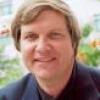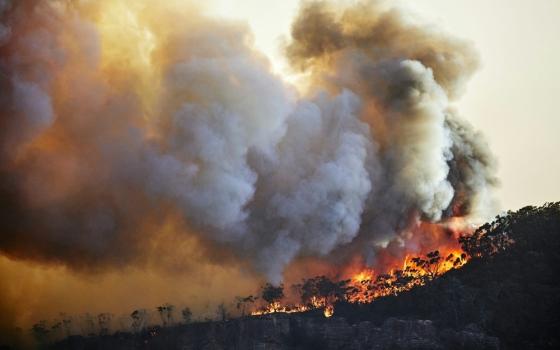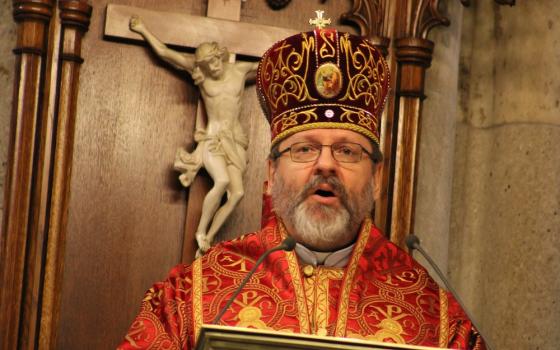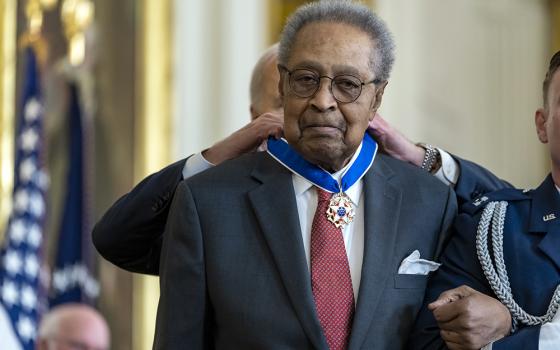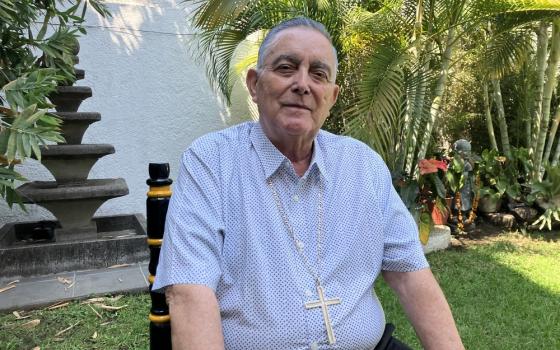While traveling in Europe in 1981, some friends and I visited Dachau, the Nazi concentration camp outside of Munich. Most of it was razed, but the original fences and barbed wire remained, along with a few buildings. That was enough to send chills down the spine. It was too much for me to take in. It's still too much for me to take in.
Upon leaving, I noticed the beautiful suburban neighborhood surrounding Dachau. The houses, green trees, streets, shrubs, shops -- it could have been any suburb in the U.S., and it was right next to the Nazi concentration camp. I was shocked and asked the officials, "Was Dachau like this 35 years ago? Were these homes here?" Yes, they answered. They smelled the smoke and went on with their lives.
The normality of evil! The suburban life of evil, the resigned acceptance of the big business of death right in one's backyard -- that's what I saw in Dachau, and that's what I saw again Sunday as I drove up the mountain to join the annual Hiroshima commemoration peace vigil at Los Alamos, N.M., the birthplace of the atomic bomb and headquarters of the U.S. nuclear weapons industry. I think it's the most evil place on earth.
It's also one of the most stunning locations in North America: the steep red cliffs, the pine trees, the Rio Grande down below, the distant mountains. And on the mesa, this beautiful, normal everytown with its Starbucks, restaurants, hotels, churches and hospital -- and nuclear weapons labs that work overtime to prepare the end of the world.
Los Alamos is in the second-richest county in the nation, with more millionaires per capita than anywhere else, even though the surrounding counties are some of the poorest. New Mexico recently returned to first place in child hunger and child poverty among the 50 states. Yet at Los Alamos, we spend billions building weapons of mass destruction.
It's a cliché to speak of the normality of evil, not to mention its banality or legality, but in Los Alamos, the big business of death surrounds you like nowhere else. Everyone is given over to death. They've gotten used to death. They've made peace with the bomb. They've become possessed by "Lord Nuke," and they don't know it. It's like walking into a zombie movie, like stepping into "Invasion of the Body Snatchers."
It was pouring rain with thunder and lightning on Sunday, so we did not process through town on our regular peace march. Instead, our little crowd gathered in the stone shelter overlooking Ashley Pond, the exact place where the Hiroshima bomb was built. As in the past, we recalled the book of Jonah, put on sackcloth and ashes, and sat in silence for 30 minutes to "repent of the mortal sin of war and nuclear weapons and beg the God of peace for the gift of nuclear disarmament."
After our silent sitting, I offered a few reflections. Then we turned to one another and shared our feelings about our prayer, Los Alamos, Hiroshima, our war-making country and the Gospel of peace. Then we had a conversation and a closing prayer.
"You and I are trying to wake up and stay awake, to open our eyes and keep our eyes open, to be conscious of the fullness of life and the evil in our midst," I said. "We're trying to noncooperate with evil, to wake others up, to call for the abolition of nuclear weapons and the reallocation of these billions of dollars for death instead for pro-human services -- for food for the hungry, homes for the homeless, universal health care, education, decent jobs, dignity and well-funded international nonviolent conflict resolution. This is the holy task God has given us: to be abnormal people of nonviolence in a world of normalized violence."
Among the disturbing aspects of Los Alamos are the packed churches. The nuclear weapons labs are made up predominantly of Christians with the full support of the local churches, including the rich, large Catholic parish of the Immaculate Heart of Mary. This is an incomparable blindness, or worse, it is comparable to the packed churches in the neighborhoods of Dachau and Auschwitz, where Nazi officials regularly attended Mass and prayers then spent the rest of their day killing our sisters and brothers.
This is a great blasphemy, and we need to name it as such. Jesus was nonviolent and called us to be peacemakers and to love our enemies, I pointed out. All Christians and all Christian churches are called to be nonviolent and to love enemies, not to support preparations to vaporize them. Christians who work at the labs, like everyone there, should quit their jobs and find new nonviolent, life-giving work and join the movement to abolish nuclear weapons.
Silent contemplative prayer is perhaps the best response to the culture of death that is Los Alamos. Sitting in sackcloth and ashes centers us in mindfulness and brings us to a clearer realization that we are all in this together, that we all share some complicity with this culture of death, that none of us are exempt. We tried to repent like the people of Nineveh, to take responsibility for our part in the culture of war and to ask our higher power for the sobriety of nonviolence. It was, of course, a modest gesture, but it's a start.
"God of peace, bless us as we repent of the sin of nuclear weapons and war," we prayed at the end. "Bless everyone here in Los Alamos and the world. Bless us all with the gift of a world without war, poverty and nuclear weapons." In the end, we felt our prayer was heard.
And that was the surprise. Everyone left consoled, renewed and hopeful. Why? Perhaps because we were not alone. If we had gone there on our own, we would have felt despair, or worse, we would have turned away and felt nothing like walking zombies. But sitting together in a communal spirit of peace and prayer, we felt uplifted. Perhaps it was because we were addressing reality, the proverbial dead elephant in the room. Perhaps most of all, it was because we tried to engage the God of peace about this work of ultimate evil. The consolation everyone felt was God's response. That was a great blessing.
Today marks the 68th anniversary of the U.S. atomic bombing of Hiroshima, and Friday is the Nagasaki anniversary. These dates invite us to reflect on the "normalcy" of our culture of death and how much we fit into it. Do we want to be like the suburban people of Dachau or Los Alamos, or can we peacefully say no to the culture of death, try to help each other wake up to the fullness of life, and turn to the God of peace for the gift of nuclear disarmament?
That's what Hiroshima asks of each one of us.
***
John Dear will speak Friday at the Wild Goose Festival in Asheville, N.C., which will also feature the Indigo Girls. In September, he will embark on a national speaking tour of Scotland. John will undertake a national speaking tour next year on his upcoming book, The Nonviolent Life. To see John's speaking schedule or to invite him to speak in your church or school, go to John Dear's website. John now works with the Francsican-based peace group Pace e Bene. He is profiled in Doing Time for Peace by Rosalie Riegle and with Daniel Berrigan and Roy Bourgeois in Divine Rebels by Deena Guzder. John's book Lazarus, Come Forth! and other recent books, including Daniel Berrigan: Essential Writings, Put Down Your Sword and A Persistent Peace, are available from Amazon.com.
Editor's note: We can send you an email alert every time a new column in "On the Road to Peace" is posted. Go to this page and follow the directions: Email alert sign-up.




